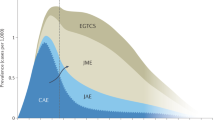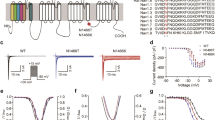Abstract
Epileptic encephalopathies are severe brain disorders with the epileptic component contributing to the worsening of cognitive and behavioral manifestations1. Acquired epileptic aphasia (Landau-Kleffner syndrome, LKS)2 and continuous spike and waves during slow-wave sleep syndrome (CSWSS)3 represent rare and closely related childhood focal epileptic encephalopathies of unknown etiology4,5. They show electroclinical overlap with rolandic epilepsy (the most frequent childhood focal epilepsy) and can be viewed as different clinical expressions of a single pathological entity situated at the crossroads of epileptic, speech, language, cognitive and behavioral disorders6,7,8,9,10. Here we demonstrate that about 20% of cases of LKS, CSWSS and electroclinically atypical rolandic epilepsy11,12,13 often associated with speech impairment can have a genetic origin sustained by de novo or inherited mutations in the GRIN2A gene (encoding the N-methyl-D-aspartate (NMDA) glutamate receptor α2 subunit, GluN2A). The identification of GRIN2A as a major gene for these epileptic encephalopathies provides crucial insights into the underlying pathophysiology.
This is a preview of subscription content, access via your institution
Access options
Subscribe to this journal
Receive 12 print issues and online access
$209.00 per year
only $17.42 per issue
Buy this article
- Purchase on Springer Link
- Instant access to full article PDF
Prices may be subject to local taxes which are calculated during checkout



Similar content being viewed by others
Accession codes
Primary accessions
GenBank/EMBL/DDBJ
NCBI Reference Sequence
References
Berg, A.T. et al. Revised terminology and concepts for organization of seizures and epilepsies: report of the ILAE Commission on Classification and Terminology, 2005–2009. Epilepsia 51, 676–685 (2010).
Landau, W.M. & Kleffner, F.R. Syndrome of acquired aphasia with convulsive disorder in children. Neurology 7, 523–530 (1957).
Patry, G., Lyagoubi, S. & Tassinari, C.A. Subclinical “electrical status epilepticus” induced by sleep in children. A clinical and electroencephalographic study of six cases. Arch. Neurol. 24, 242–252 (1971).
Nieuwenhuis, L. & Nicolai, J. The pathophysiological mechanisms of cognitive and behavioral disturbances in children with Landau-Kleffner syndrome or epilepsy with continuous spike-and-waves during slow-wave sleep. Seizure 15, 249–258 (2006).
Van Bogaert, P. & Paquier, P.F. Landau-Kleffner syndrome: 50 years after. Epilepsia 50 (suppl. 7), 1–2 (2009).
Arzimanoglou, A., Aicardi, G.R. & Aicardi, J. Landau-Kleffner syndrome and syndrome of continuous spike-waves of slow sleep. in Epilepsy in Children 3rd edn 176–187 (Lippincott, Williams & Wilkins, Philadelphia, 2004).
Deonna, T. & Roulet, E. Autistic spectrum disorder: evaluating a possible contributing or causal role of epilepsy. Epilepsia 47 (suppl. 2), 79–82 (2006).
Deonna, T. & Roulet-Perez, E. Early-onset acquired epileptic aphasia (Landau-Kleffner syndrome, LKS) and regressive autistic disorders with epileptic EEG abnormalities: the continuing debate. Brain Dev. 32, 746–752 (2010).
Rudolf, G., Valenti, M.P., Hirsch, E. & Szepetowski, P. From rolandic epilepsy to continuous spike-and-waves during sleep and Landau-Kleffner syndromes: insights into possible genetic factors. Epilepsia 50 (suppl. 7), 25–28 (2009).
Tuchman, R. CSWS-related autistic regression versus autistic regression without CSWS. Epilepsia 50 (suppl. 7), 18–20 (2009).
Datta, A. & Sinclair, D.B. Benign epilepsy of childhood with rolandic spikes: typical and atypical variants. Pediatr. Neurol. 36, 141–145 (2007).
Fejerman, N. Atypical rolandic epilepsy. Epilepsia 50 (suppl. 7), 9–12 (2009).
Massa, R. et al. EEG criteria predictive of complicated evolution in idiopathic rolandic epilepsy. Neurology 57, 1071–1079 (2001).
Lesca, G. et al. Epileptic encephalopathies of the Landau-Kleffner and continuous spike and waves during slow-wave sleep types: genomic dissection makes the link with autism. Epilepsia 53, 1526–1538 (2012).
Salter, M.W. & Kalia, L.V. Src kinases: a hub for NMDA receptor regulation. Nat. Rev. Neurosci. 5, 317–328 (2004).
Stephani, U. & Carlsson, G. The spectrum from BCECTS to LKS: the Rolandic EEG trait—impact on cognition. Epilepsia 47 (suppl. 2), 67–70 (2006).
Roll, P. et al. SRPX2 mutations in disorders of language cortex and cognition. Hum. Mol. Genet. 15, 1195–1207 (2006).
Traynelis, S.F. et al. Glutamate receptor ion channels: structure, regulation, and function. Pharmacol. Rev. 62, 405–496 (2010).
Talukder, I., Borker, P. & Wollmuth, L.P. Specific sites within the ligand-binding domain and ion channel linkers modulate NMDA receptor gating. J. Neurosci. 30, 11792–11804 (2010).
Yuan, H., Hansen, K.B., Vance, K.M., Ogden, K.K. & Traynelis, S.F. Control of NMDA receptor function by the NR2 subunit amino-terminal domain. J. Neurosci. 29, 12045–12058 (2009).
Reutlinger, C. et al. Deletions in 16p13 including GRIN2A in patients with intellectual disability, various dysmorphic features, and seizure disorders of the rolandic region. Epilepsia 51, 1870–1873 (2010).
Endele, S. et al. Mutations in GRIN2A and GRIN2B encoding regulatory subunits of NMDA receptors cause variable neurodevelopmental phenotypes. Nat. Genet. 42, 1021–1026 (2010).
de Ligt, J. et al. Diagnostic exome sequencing in persons with severe intellectual disability. N. Engl. J. Med. 367, 1921–1929 (2012).
Carvill, G.L. et al. GRIN2A mutations cause epilepsy-aphasia spectrum disorders. Nat. Genet. published online; doi:10.1038/ng.2727 (11 August 2013).
Cloarec, R. et al. PRRT2 links infantile convulsions and paroxysmal dyskinesia with migraine. Neurology 79, 2097–2103 (2012).
Lee, H.Y. et al. Mutations in the gene PRRT2 cause paroxysmal kinesigenic dyskinesia with infantile convulsions. Cell Rep. 1, 2–12 (2012).
Boscolo, S. et al. Anti-brain but not celiac disease antibodies in Landau-Kleffner syndrome and related epilepsies. J. Neuroimmunol. 160, 228–232 (2005).
Connolly, A.M. et al. Serum autoantibodies to brain in Landau-Kleffner variant, autism, and other neurologic disorders. J. Pediatr. 134, 607–613 (1999).
Dalmau, J. et al. Anti-NMDA-receptor encephalitis: case series and analysis of the effects of antibodies. Lancet Neurol. 7, 1091–1098 (2008).
Kalia, L.V., Kalia, S.K. & Salter, M.W. NMDA receptors in clinical neurology: excitatory times ahead. Lancet Neurol. 7, 742–755 (2008).
Miyamoto, H., Katagiri, H. & Hensch, T. Experience-dependent slow-wave sleep development. Nat. Neurosci. 6, 553–554 (2003).
Wei, X. et al. Exome sequencing identifies GRIN2A as frequently mutated in melanoma. Nat. Genet. 43, 442–446 (2011).
Roll, P. et al. Infantile convulsions with paroxysmal dyskinesia (ICCA syndrome) and copy number variation at human chromosome 16p11. PLoS ONE 5, e13750 (2010).
Irani, S.R. et al. N-methyl-D-aspartate antibody encephalitis: temporal progression of clinical and paraclinical observations in a predominantly non-paraneoplastic disorder of both sexes. Brain 133, 1655–1667 (2010).
Popescu, G. & Auerbach, A. Modal gating of NMDA receptors and the shape of their synaptic response. Nat. Neurosci. 6, 476–483 (2003).
Wyllie, D.J., Johnston, A.R., Lipscombe, D. & Chen, P.E. Single-channel analysis of a point mutation of a conserved serine residue in the S2 ligand-binding domain of the NR2A NMDA receptor subunit. J. Physiol. (Lond.) 574, 477–489 (2006).
Acknowledgements
We thank all the subjects and families who participated in the study. Written informed consent was obtained from parents for their children and for themselves, according to the appropriate bioethics laws and ethical committees (no. 05/78, CPP Strasbourg, Alsace 1). We thank C. Boulay, M. Lim, E. Panagiotakaki, C. Seegmuller and M.-P. Valenti-Hirsch for their valuable participation in clinical analyses, R. Lamy for expert technical assistance, F. Michel at inMAGIC (INMED Imaging Centre) and all the administrative staff at INMED. Assistance from the Biological Resource Centre, Hospices Civils (Lyon, France) and from the Banque de Génome, Hôpital de Brabois (Vandoeuvre-les-Nancy, France) was greatly appreciated. S.W. is supported by the Wellcome Trust. P.W. and A.V. are partly supported by the NIHR Oxford Biomedical Research Centre. This work was supported by ANR (Agence Nationale de la Recherche) grant EPILAND (ANR-2010-BLAN-1405 01) with EuroBiomed label, by National PHRC (Projet Hospitalier de Recherche Clinique) grant 2010 03-08 and by INSERM.
Author information
Authors and Affiliations
Contributions
G.L. and G.R. coordinated the collection of samples and of clinical information, performed and analyzed genetic data and participated in the study design, with equal contributions. N. Bruneau supervised and carried out the synthesis of the constructs, performed the in vitro assays and the immunocytochemistry experiments and participated in cell-based electrophysiological assays and in study design. N.L., T.T., V.T. and N. Burnashev performed and designed all electrophysiological studies and related data analyses. J.M., A.M., D.D., K.L., J.d.B., P.V., A.S.M., D.V., P.R., A.A., D.P. and E.H. performed phenotyping analysis and clinical data collection. A.L., N.B.-K., M.S., L.A., L.S. and D.P. participated in genetic experiments and analyses. S.W., P.W. and A.V. performed the in vitro immunological assays. D.S. participated in the overall strategy and in genetic data analyses and supervision. P.S. was the project leader. He decided on the overall strategy, directed the follow-up of experiments, supervised data analysis and wrote the manuscript with G.L. and G.R. and with help from N. Bruneau, N.L., N. Burnashev and D.S. All authors contributed to the final version of the manuscript.
Corresponding author
Ethics declarations
Competing interests
A.V. and the University of Oxford hold patents and receive royalties and payments for antibody assays for the diagnosis of neurological diseases such as myasthenia gravis and different forms of autoimmune encephalitis.
Supplementary information
Supplementary Text and Figures
Supplementary Figures 1–6, Supplementary Tables 1 and 2, and Supplementary Note (PDF 3119 kb)
Source data
Rights and permissions
About this article
Cite this article
Lesca, G., Rudolf, G., Bruneau, N. et al. GRIN2A mutations in acquired epileptic aphasia and related childhood focal epilepsies and encephalopathies with speech and language dysfunction. Nat Genet 45, 1061–1066 (2013). https://doi.org/10.1038/ng.2726
Received:
Accepted:
Published:
Issue Date:
DOI: https://doi.org/10.1038/ng.2726
This article is cited by
-
Therapeutic potential of N-methyl-D-aspartate receptor modulators in psychiatry
Neuropsychopharmacology (2024)
-
Differential functional consequences of GRIN2A mutations associated with schizophrenia and neurodevelopmental disorders
Scientific Reports (2024)
-
Disease-associated nonsense and frame-shift variants resulting in the truncation of the GluN2A or GluN2B C-terminal domain decrease NMDAR surface expression and reduce potentiating effects of neurosteroids
Cellular and Molecular Life Sciences (2024)
-
Genetik und genetische Diagnostik fokaler Epilepsien des Kindesalters – Was? Wann? Warum?
Clinical Epileptology (2024)
-
Spike-spindle coupling during sleep and its mechanism explanation in childhood focal epilepsy
Cognitive Neurodynamics (2024)



